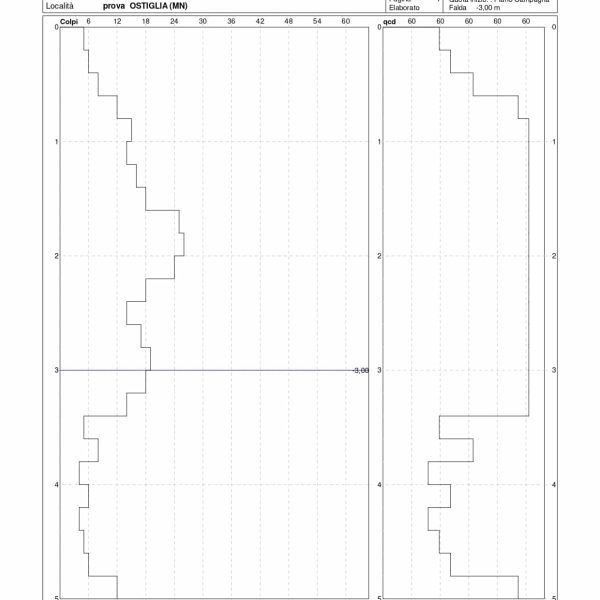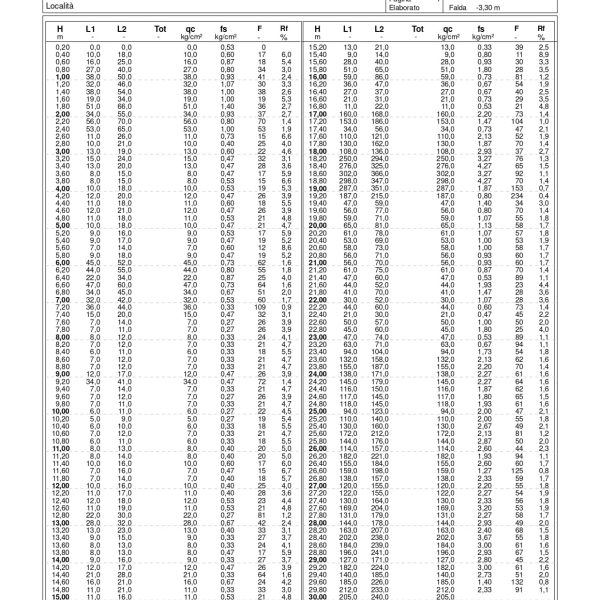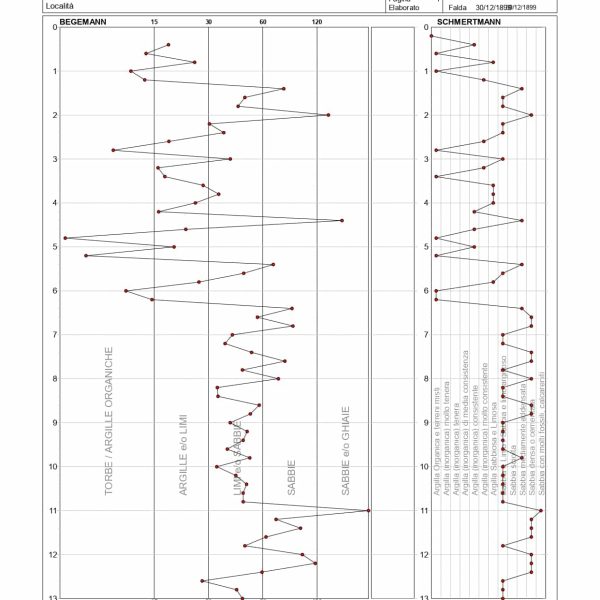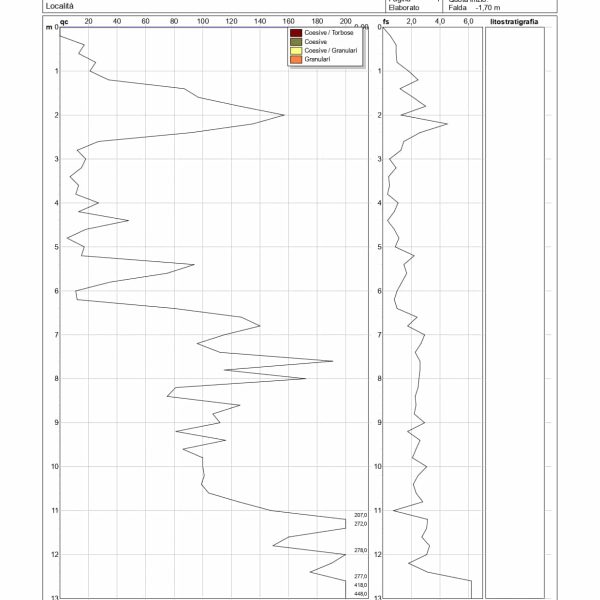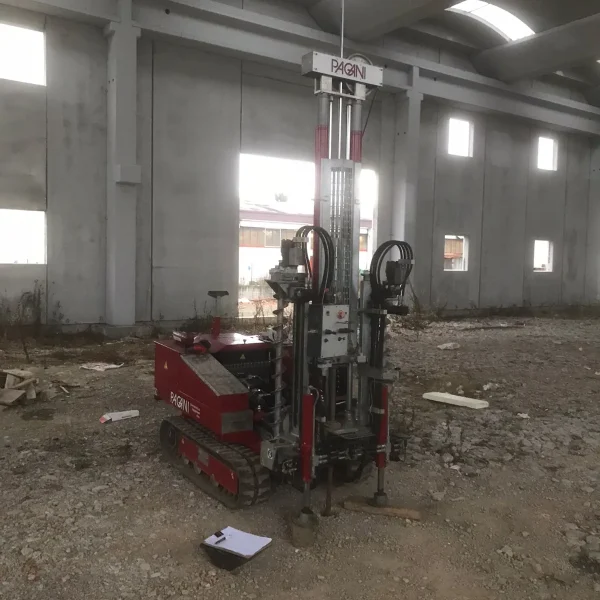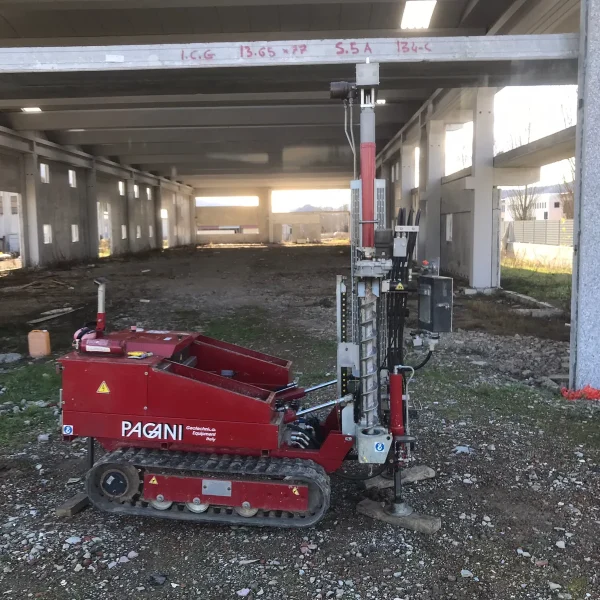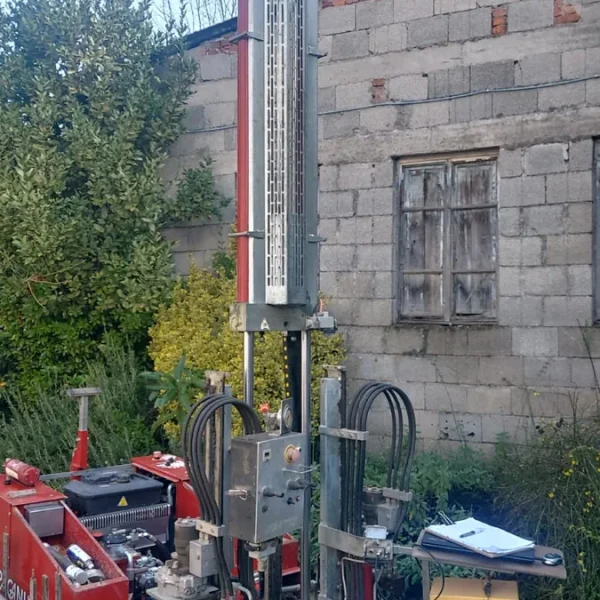Penetration tests
Static penetration tests
The static penetration tests C.P.T. (Cone Penetration Test) are very widespread surveys because, at a modest cost, they allow us to estimate many geotechnical parameters of both coarse-grained (except gravel) and fine-grained soils.
The test is self-drilling, i.e. it does not require the execution of a borehole, and consists of pressure driving into the ground, starting from ground level and at a constant speed of 20 mm/s (with a tolerance of 5 mm/s ) of a conical tip having a diameter of 35.7 mm and an opening angle of 60°, connected to the pusher by means of a battery of tubes. The necessary contrast to drive the tip and the battery of rods into the ground is obtained with the weight of the truck, possibly ballasted, on which the equipment is installed, or by means of anchor screws “screwed” into the ground, or again by means of “bolts” applied to flooring.
There are two types of static penetration tests, with geometric characteristics and internationally standardized test procedures:
- Static penetration test with friction sleeve
- Static penetration test with electric penetrometer
In mechanical penetrometers with friction sleeve (Begemann tip) the conical tip is integral with a battery of coaxial rods and a casing pipe. The final part, i.e. the one close to the tip, of the casing pipe is mobile and forms the friction sleeve.
- Initially, by exerting a force on the internal rods connected to the tip, the tip alone is moved forward at a constant speed of 2 cm/s for a length of 40 mm
- At the end of the 40 mm stroke, the friction sleeve is engaged and the bit continues to advance at a constant speed for another 40 mm (which drags the sleeve during penetration)
- In a third phase, the thrust is applied to the external rods which, with the tip at a standstill, first reach the sleeve and then the tip to then advance together.
The operation is repeated every 20 centimeters of advancement. The pressure exerted on the tip – through the rods – is transmitted to electronic pressure gauges or load cells placed at the top of the rods themselves. With these tools we read:
- Reading to the tip
- Reading at the tip and sleeve
- Total reading (advancement of the bit and of the entire set of rods).
From these readings the following parameters are obtained:
- Unit resistance at tip qc (Kg/cm2 or in KPa)
- Lateral friction unit resistance fs (Kg/cm2 or in KPa)
- Begemann ratio, given by the ratio of the first two parameters, which provides an estimate of the particle size of the deposit crossed.
The static penetrometric test with an electric penetrometer consists in driving a conical tip with standard dimensions into the ground, at a constant speed, through a battery of hollow rods. A signal cable is passed through the rods.
The digital tip has a series of sensors that measure deviation from vertical (tilt) as well as tip resistance (qc) and lateral friction (fs).
The CPTU static penetrometric tests using the piezocone (electric tip) improving the data obtained in the static tests both in terms of measurement precision and as data sampling frequency. With the piezocone it is in fact possible to acquire, during the continuous thrust movement, the quantities qc (tip resistance) and fs (lateral friction) at each centimeter of depth.
The possibility of measuring the interstitial pressure has considerably increased the interpretative capacity of the test in saturated soils below the water table. Furthermore, since the sensitivity of the instrument to the variation of interstitial pressures is very high as it is not affected by scale effects, it is also possible to identify thin layers of soil with different permeability, the presence of which can be decisive in estimating consolidation times.
Dynamic penetration tests
With the dynamic penetration method a conical point is driven into the ground and the strokes needed to drive the point every 15 cm are counted and noted. This type of test is very popular because it is easy to do, done quickly and cheap.
The elaboration and interpretation of a dynamic penetrometric test allow to “catalogue and parameterise” the investigated terrain, which also allows for a comparison of the consistencies of the various levels crossed and a direct correlation with geognostic surveys and consequently with the stratigraphy of the ground.
Furthermore, the dynamic penetration tests allow to recognize quite precisely the thickness of the coulters on the substrate, the height of any groundwater and failure surfaces on the slopes and the general consistency of the soil.
The use of the data, obtained from indirect correlations and referring to various authors, must in any case be treated with the appropriate precautions and, possibly, After geological experiences acquired on the ground.
The dynamic penetrometer
The characteristic elements of a dynamic penetrometer are these:
- Swing mass weight M
- Free fall height H
- Cone tip: cone base diameter D, base area A (spread angle α)
- Feed step (delta).
Dynamic penetrometers are classified into four classes (according to the weight M of the striking mass). Consequently we have four types of dynamic penetration tests:
- Light Penetrometric Test (DPL)
- Medium Penetrometric Test (DPM)
- Heavy penetration test (DPH)
- Super Heavy Penetrometer Test (DPSH)
The following table shows the four types of penetrometer:
|
Type |
Reference symbol |
Weight of mass M (Kg) |
Max investigation depth |
|
Light penetrometer |
DPL (Light) |
M≤10 |
8 |
|
Medium penetrometer |
DPM (Medium) |
10<M<40 |
20-25 |
|
Heavy penetrometer |
DPH (Heavy) |
40≤M<60 |
25 |
|
Super-heavy penetrometer |
DPSH |
M>60 |
25 |
The DL30 light penetrometric tests are performed in contexts of difficult accessibility using a DL30 Light Dynamic Penetrometer type “Sunda 30” (according to the ISSMFE 1998 procedures), with rods advancing every 10 cm.
Built according to DIN 4094 standards, it has a hammer with a mass of 30 kg like the DPM Medium Dynamic Penetrometer.
The DL30 penetration tests are Geotechnical Investigations on site performed by driving a disposable metal conical tip, placed at the end of a steel rod that can be extended with a battery of rods with a diameter of 20 mm.
The driving energy is provided by a hammer weighing 30.0 kg which falls from a constant height of 20.0 cm, by means of an automatic release device, performing a specific work equal to 60 kj/ sqm.
During the test, the number of blows necessary for the tip to penetrate 10 cm is measured.
Seismic cone
The seismic cone survey is carried out thanks to a metal tip suitably equipped with a geophonic triad. The test is carried out after a static or dynamic penetration test, in order to also determine the dynamic characteristics of the site. The prospecting consists in replacing the penetrometric tip with a particular cone equipped with a geophonic triad and measuring, in addition to the normal parameters of resistance to the tip (qc), lateral friction (fs) and neutral pressure (U), the speed of the shear waves and/or compression (Vs, Vp) in-situ.
The seismic cone uses the same principle as the down-hole test: the travel times of the seismic waves that propagate from the ground level to the geophonic triad inside the seismic tip located at different depths are measured.
The test is reliable, cheap and fast, allowing similarly to the down hole test to have a very detailed profile of the seismic speeds without resorting to the execution of the sounding and subsequent equipment.
From the speed of the compression (Vp) and shear (Vs) waves found during the survey, it is possible to calculate the main elastic moduli (Poisson’s coefficient, Young’s modulus, dynamic shear modulus) and relate them to the geotechnical parameters obtained from the penetration test, directly by superimposing the graphs.
Equipments
- Pagani TG 63-200 penetrometer

